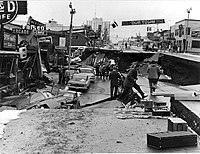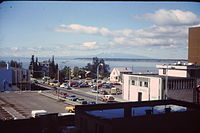History of Anchorage, Alaska
After congress approved the completion of the Alaska Railroad from Seward to Fairbanks in 1914, it was decided that a new town should be built as a port and rail hub along the route. The decision was made to develop a site near Ship Creek on Cook Inlet. Survey parties visited the area in 1914 and researched possible routes for the rails and options for siting the new town. Anchorage was originally settled as a
The strategic location of Alaska, which led to a massive buildup of military facilities throughout Alaska during the years of World War II, changed that. Largely due to the military presence and resource development activities throughout Alaska, Anchorage has enjoyed significant boosts to its population and economic base from 1940 to the present.
The 1964 Alaska earthquake outright destroyed or caused significant damage to most of the Anchorage neighborhoods adjacent to Knik Arm, including its downtown. The community rapidly rebuilt, and has since emerged as a major American city.
Early history
According to archaeological evidence discovered at
Cook's expedition
When
For a period of ten days, Cook made an extensive survey of the inlet, which at its head split into two arms. Under a bluff near the mouth of Ship Creek, Cook anchored his ship, HMS Resolution, and had his first encounter with the local Natives as two men approached in kayaks, beckoning them ashore. He sent William Bligh in a boat to scout the north arm, where he met with some local Natives who told him the arm only led to two rivers, called the Knik and Matanuska Rivers. Cook sailed south to scout the other arm, but was unable to sail down it against the strong tides and ran aground on a sandbar while trying to get back out, and had to wait for high tide. Described by George Vancouver as being in a "foul mood", Cook called the arm "River Turnagain". Cook then sailed back to retrieve Bligh, and before leaving he sent James King ashore with a Union Jack to claim the region for King George III. There, King met with some friendly Natives, where they shared some bottles of wine, and gave a toast to King. King gave them the empty bottles, except one, which he stuffed with some papers and buried under a tree where he said, "...in many ages hence it may puzle antiquarians." As Cook sailed away, many Natives stood along the shores of the inlet waving skins or spreading their arms wide in gestures of peace. Cook remarked that the Natives of the area seemed very honest, being only interested in fair trade. He noted that many of them had iron knives or spearheads, surmising that other traders, possibly Russian, had been there before.
Cook never gave the inlet a name, although King referred to it as the "Great River". Years later, John Montagu, 4th Earl of Sandwich in London, changed the name to "Cook's River".[4] In 1792, George Vancouver returned and more thoroughly mapped the area, renaming it Cook Inlet, complaining of Cook's voyage that, had they simply stayed for one more day, they could have finished the map and avoided a decade of speculation.[5]
Russian occupation
Gold rush
By 1888, gold was discovered along Turnagain Arm at Resurrection Creek, and the small towns of Hope and Sunrise formed. As a new influx of prospectors flooded the area, small amounts of gold were found in several of the other fjords, and small communities such as Indian, Girdwood, and Portage began to spring up in nearly every one. Lumber and coal were quickly needed, which were imported from the Matanuska Valley, and Joe Spenard constructed a lumber mill that was to become the town of Spenard, just south of modern downtown Anchorage.
The fur trade was still a profitable enterprise, and many of the mountain ranges formed natural funnels leading to the Cook Inlet, along a variety of trails that had been used for centuries by Native tribes. With deposits of coal and vast growths of lumber in the Matanuska and Susitna Valleys, and dog sleds packed with gold arriving from strikes in places like
Alaska Railroad

In 1914, congress passed the
As news spread of the prospect of work, a new stampede of people flocked to the Knik Anchorage. Mears arrived to find over 2000 people living on the flats surrounding Ship Creek in ragged tents and makeshift shelters, and unsanitary conditions starting to develop. In addition, as many as 100 people continued to arrive each week. Mears requested that a town site be mapped out above the higher bluffs south of the creek, and President Wilson signed the order later that year, under the provision that the new town become a model of sobriety. To ensure this, an experimental plan was put into place where land was auctioned off to the people but could be forfeited if a person was caught violating the alcohol laws.
The waters near Ship Creek, although not a deep-water port, were deep enough for barges and small ships, and a dock was constructed for offloading cargo and railroad supplies. As Knik Anchorage grew, the town of Knik dwindled and finally became a ghost town. The post office moved to the Knik Anchorage, who shortened the name to simply "Anchorage", deeming that all packages and letters should be addressed accordingly. However, in August the people were given a chance to vote on the name, and many options were tossed about, including "Matanuska", "Ship Creek", "Homestead", "Terminal", and "Gateway". The name "Alaska City" won the vote, but the federal government ultimately declined the request.[10]
Statehood
Between the 1930s and 1950s,
Starting in the 1940s, military presence in Alaska was also greatly expanded. Elmendorf Air Force Base and Fort Richardson were constructed, and Anchorage became the headquarters of the Alaska Defense Command. Heavy military investment occurred during World War II, due to the threat of Japanese invasion, and continued into 1950, because of Cold War tensions.[9]
In the 1940s and 1950s, Anchorage began looking more like a city. Between 1940 and 1951, Anchorage's population increased from 3,000 to 47,000. Crime and the cost of living in the city also grew. In 1949, the first
On January 3, 1959, Alaska joined the union as the 49th state. Soon after, Anchorage faced a severe housing shortage, which was solved partially by suburban expansion.
Growth and development

On March 27, 1964, Anchorage was hit by the Good Friday earthquake, which caused significant destruction.[13][14] The magnitude 9.2 earthquake was the largest ever recorded in North America, and Anchorage lay only 75 miles (121 km) from its epicenter.[13][14]
The earthquake killed 115 people in Alaska, and damage was estimated at over $300 million ($1.8 billion in 2007 U.S. dollars).[13][14] It was the second largest earthquake in the recorded history of the world.[13][14] Anchorage's recovery from the earthquake dominated life in the late 1960s.
In 1968, oil was discovered in Prudhoe Bay on the Arctic Slope; a 1969 oil lease sale brought billions of dollars to the state. In 1974, construction began on the Trans-Alaska Pipeline System. The pipeline was completed in 1977 at a cost of more than $8 billion. The oil discovery and pipeline construction fueled a boom when oil and construction companies set up headquarters in Anchorage. The Anchorage International Airport also boomed as well, and Anchorage marketed itself as the "Air Crossroads of the World," due to its geographical location.[9]

In 1975, the city and borough consolidated, forming a
The decade of the 1980s started as a time of growth, thanks to a flood of North Slope oil revenue into the state treasury. Capital projects and an aggressive beautification program, combined with far-sighted community planning, greatly increased infrastructure and quality of life. Major improvements included a new library, a civic center, a sports arena, a performing arts center, Hilltop Ski Area, and Kincaid Outdoor Center.[9] The 1980s oil glut lead to an economic recession in Anchorage.[16]
Recent history
On July 8, 2000, the airport was renamed Ted Stevens Anchorage International Airport in honor of Alaska's longest-serving senator.[7] Although development is filling available space in the "Anchorage bowl"—a local moniker for the city area—significant undeveloped areas still remain, as well as large areas of dedicated parks and greenbelts.
On November 30, 2018, Anchorage experienced a 7.0 magnitude quake, as well as numerous aftershocks. Some buildings and roadways were damaged, and communication and other services were partially disrupted, but no fatalities were reported. The quake, centered about five miles north of the city, was the largest to shake the area since the massive 1964 quake. A tsunami warning was issued and later withdrawn. [17][18]
See also
References
- ^ Aunt Phil's Trunk: Bringing Alaska's history alive! Volume 3 by Laurel Bill, Phyllis Carlson – Aunt Phil's Trunk LLC 2016 pp. 1–5
- ^ US Bureau of Reclamation: Eklutna Project
- ^ Aunt Phil's Trunk: Bringing Alaska's history alive! Volume 3 by Laurel Bill, Phyllis Carlson – Aunt Phil's Trunk LLC 2016 pp. 1–5
- ^ Naske & Rowinski 1981, p. 17.
- ^ McLynn, Frank (2011). Captain Cook: Master of the Seas. Yale University Press.[ISBN missing][page needed]
- ^ Naske & Rowinski 1981, pp. 18–19.
- ^ a b "Timeline". Anchorage Chamber of Commerce. Archived from the original on September 30, 2011. Retrieved July 8, 2011.
- ^ Naske & Rowinski 1981, pp. 21–32.
- ^ a b c d e f g "Anchorage Historical Highlights." Archived 2007-04-06 at the Wayback Machine Municipality of Anchorage website. Accessed Apr. 6, 2007.
- ^ Naske & Rowinski 1981, pp. 41–43.
- ^ City of Anchorage, Alaska. Anchorageak.com. Accessed May 21, 2012.
- ^ Anchorage: History. City-Data.com. Accessed May 21, 2012.
- ^ a b c d "The Great Alaska Earthquake of 1964". Geophysical Institute, UAF. Alaska Earthquake Information Center. Archived from the original on July 6, 2011. Retrieved July 4, 2011.
- ^ a b c d "Historic Earthquakes, Prince William Sound, Alaska". USGS. Archived from the original on August 25, 2009. Retrieved July 4, 2011.
- ^ "Community Database Online, Anchorage". Alaska Division of Community and Regional Affairs. Archived from the original on March 24, 2012. Retrieved July 4, 2011.
- ISBN 978-0-300-17394-9.
- ^ "Alaska Earthquake: TV Stations Off Air Amid Extensive Damage From 7.0 Temblor, Aftershocks; Tsunami Warning Canceled". Deadline. November 30, 2018. Retrieved March 16, 2023.
- ^ "Magnitude 7.0 earthquake rattles Anchorage, unleashes powerful aftershocks". Los Angeles Times. December 1, 2018. Retrieved March 16, 2023.
Sources
- Naske, Claus M.; Rowinski, Ludwig J. (1981). Anchorage: A Pictorial History. Donning Company. ISBN 0898651069.
External links
![]() Media related to History of Anchorage, Alaska at Wikimedia Commons
Media related to History of Anchorage, Alaska at Wikimedia Commons




